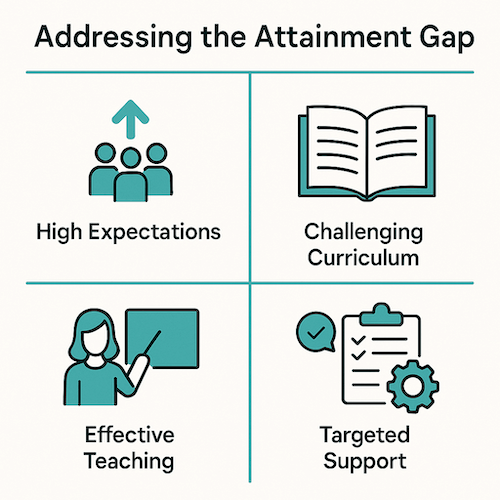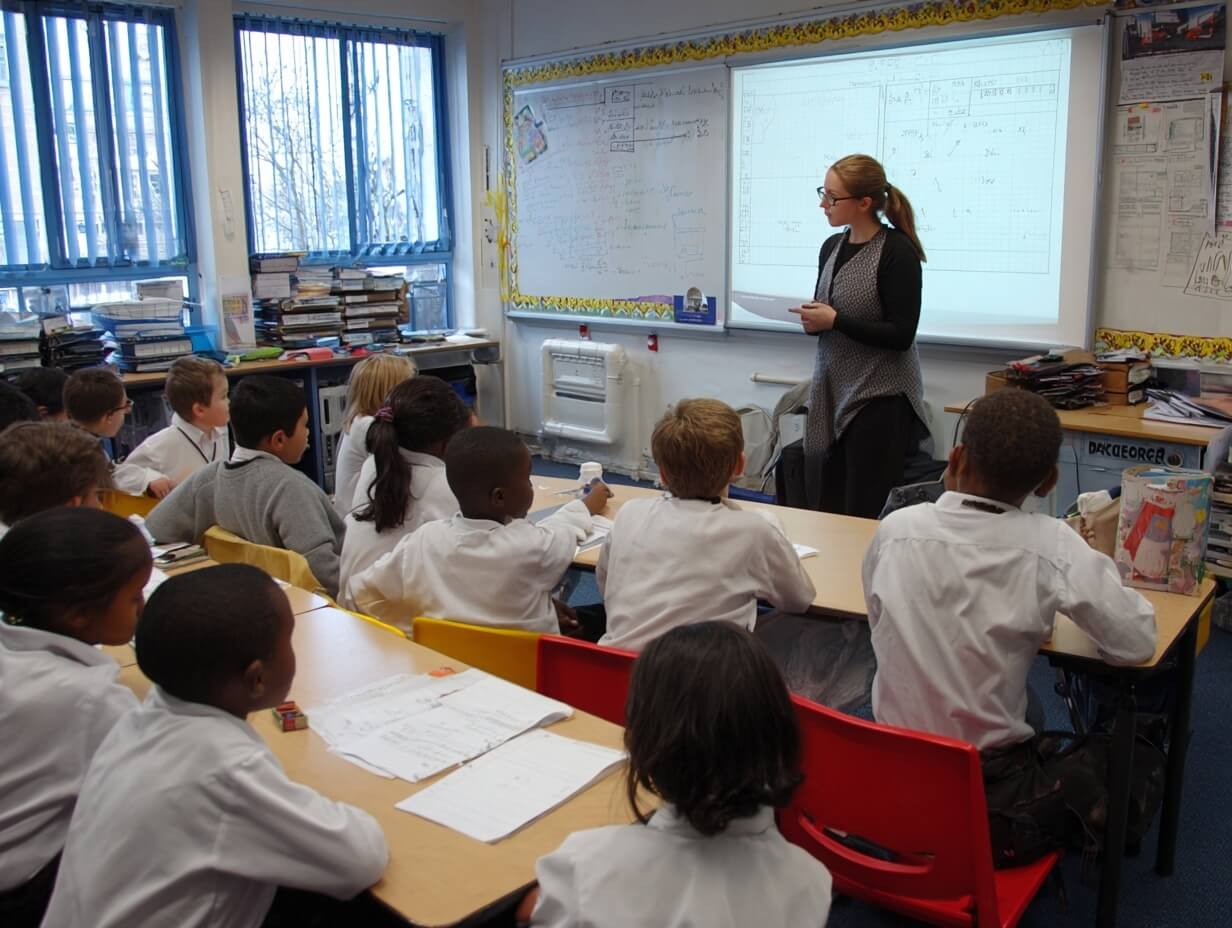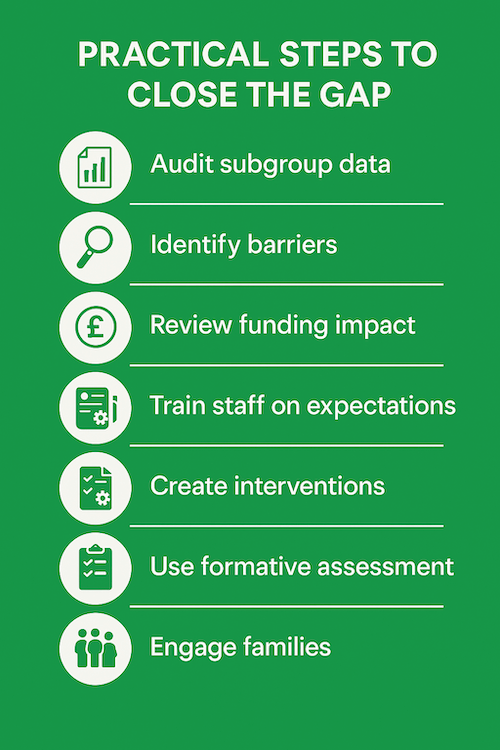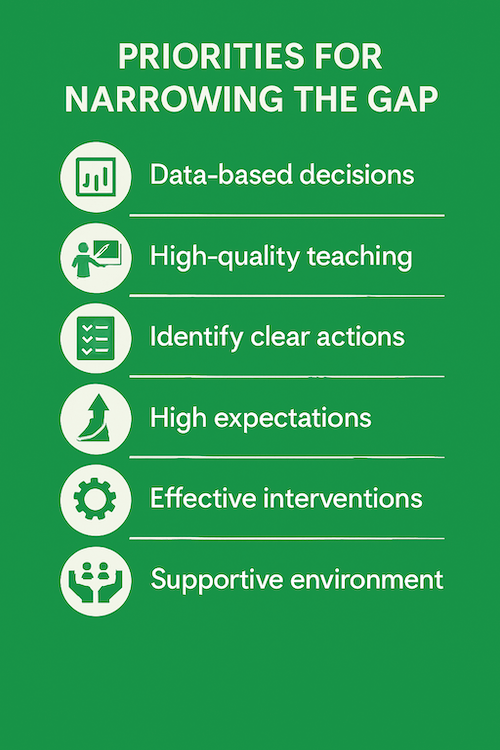Attainment Gap: A teacher's guide
Understand the attainment gap in UK schools and discover evidence-based strategies for supporting disadvantaged pupils and closing achievement disparities.


The attainment gap represents one of education's most persistent challenges. Understanding its causes and implementing evidence-based strategies can help schools support all learners effectively.
The attainment gap describes the difference in educational achievement between subgroups of students. These disparities typically emerge along lines of socioeconomic status, ethnicity, gender, and special educational needs. For UK state schools, this metric has become central to accountability frameworks.
Schools receiving pupil premium funding must demonstrate how specific activities help disadvantaged pupils progress. Education providers need clear evidence showing how they advance opportunities for society's most vulnerable learners. The Education Endowment Foundation provides schools with research-backed approaches that can significantly impact children's educational trajectories.
The pandemic amplified existing inequalities. Learning loss during school closures hit children from disadvantaged backgrounds hardest, revealing schools' transformative potential. Academic activities coordinated in school settings help students overcome barriers to learning they would otherwise face without targeted support.

Multiple interconnected factors influence student achievement across different demographic groups.
Basic necessities affect learning capacity. Issues with nutrition, housing, clothing, and transport create immediate barriers to education access. Additional costs for resources, school trips, uniforms, and technology deepen inequalities. Students without reliable internet or devices face compounded disadvantages in today's digital learning environment.
School funding disparities mean students in deprived areas often learn from less experienced teachers with fewer resources. These structural inequalities create cumulative disadvantages that affect long-term outcomes.
Teacher decisions about class leadership, streaming arrangements, and grouping strategies directly impact attainment patterns. Class size affects individual attention and support available to struggling learners. Even peer composition within classrooms shapes achievement through collaborative learning dynamics and behavioral expectations.
The largest gaps exist between students eligible for free school meals and those with SEND. Free school meals serve as the primary indicator of economic disadvantage in UK education data. Achievement gaps emerge early, becoming measurable by age five.

Understanding root causes helps schools develop targeted interventions.
Children from low-income households face multiple educational challenges. Persistent poverty affects cognitive development, school readiness, and sustained engagement with learning. These effects compound over time, creating widening gaps as students progress through school.
Empirical evidence shows increasing educational inequality among ethnic groups creates additional learning barriers. While this article focuses on socioeconomic factors, comprehensive approaches must address intersecting disadvantages.
School location influences educational outcomes through varied mechanisms. Geographic isolation can increase dropout rates, reduce attendance, limit enrichment opportunities, and concentrate social challenges.
Standardised testing may inadvertently widen gaps. Test preparation reduces learning time, narrows curriculum focus, and can stigmatise schools serving disadvantaged communities. Misinterpretation of assessment data sometimes leads to inappropriate interventions.
Teacher expectations powerfully influence student achievement through self-fulfilling prophecies. According to Jon Saphier (2016), students absorb messages about their abilities from important adults. Teachers unconsciously communicate expectations through tone, body language, behavior, and word choices.
Students with SEND face particular challenges when teacher expectations limit opportunities. These learners often experience marginalisation within mainstream education settings. COVID-19 intensified concerns about disadvantaged children's progress, particularly those switching between school and home learning.

No quick fixes exist for educational inequality. Schools need comprehensive, sustained approaches tailored to their contexts.
Educational expert Daniel Sobel emphasises quality-first teaching based on vulnerable children's individual needs. Schools must develop personalised strategies rather than applying generic interventions. This requires understanding each student's specific challenges and strengths.
Professional development helps staff identify root causes of underachievement. Teachers should design interventions based on direct conversations with students. Schools can analyse performance data to identify trends among disadvantaged pupils, using these insights to refine strategies.
Research shows calm home learning environments enable children from all backgrounds to achieve above-average outcomes. Schools can support families in creating these conditions through parent engagement and community partnerships.
COVID-19 highlighted digital divides affecting disadvantaged students. Consistent device access and reliable internet connections remain fundamental requirements for modern learning. Schools must audit and address technology gaps systematically.
Attendance represents another critical factor. Schools need comprehensive approaches addressing underlying causes, whether through improved healthcare access, uniform banks, extra tutoring, walking school buses, or wraparound care provision.

Effective Pupil Premium use requires strategic planning and evaluation. Post-pandemic priorities include building resilience, supporting mental health, and promoting wellbeing in schools. Schools must balance academic interventions with holistic support addressing social and emotional needs.
Investment in teaching assistant courses ensures support staff can effectively help vulnerable learners. Training should cover both academic support strategies and understanding of cognitive development principles.
Teaching effectiveness remains the most significant school-level factor influencing achievement.
High-quality teaching benefits all students but particularly impacts disadvantaged learners. Schools serving deprived communities need incentives to attract and retain skilled teachers. Ongoing evidence-informed practice development ensures staff stay current with effective approaches.
Support staff and teaching assistants fulfill crucial roles addressing social, emotional, and academic needs. Tiered support systems help schools implement evidence-based interventions systematically. Responsive teaching approaches allow educators to adapt strategies based on individual progress.

Jon Saphier's 'High Expectations Teaching' emphasises how teacher beliefs shape student outcomes. Students internalise messages about their capabilities from influential adults. Teachers must practice self-reflection to ensure they consistently communicate high expectations for all learners.
This requires examining unconscious biases that might limit opportunities for certain groups. Schools should establish cultures where all students receive challenging, engaging instruction regardless of background or prior attainment.
Despite challenges, educators have achieved meaningful progress in recent decades. Success comes from focusing on core educational quality:
Engaged, challenged students receiving culturally responsive instruction that connects to their experiences and aspirations.
Passionate, skilled teachers demonstrating cultural awareness and commitment to equity through their practice.
Visionary, collaborative leaders creating conditions for excellence through strategic resource allocation and culture building.
No individual can close achievement gaps alone. The education sector needs coordinated initiatives mobilising expertise across all organisational levels. When schools, districts, and communities align efforts, they create genuine opportunities for excellence regardless of student background.
The attainment gap represents one of education's most persistent challenges. Understanding its causes and implementing evidence-based strategies can help schools support all learners effectively.
The attainment gap describes the difference in educational achievement between subgroups of students. These disparities typically emerge along lines of socioeconomic status, ethnicity, gender, and special educational needs. For UK state schools, this metric has become central to accountability frameworks.
Schools receiving pupil premium funding must demonstrate how specific activities help disadvantaged pupils progress. Education providers need clear evidence showing how they advance opportunities for society's most vulnerable learners. The Education Endowment Foundation provides schools with research-backed approaches that can significantly impact children's educational trajectories.
The pandemic amplified existing inequalities. Learning loss during school closures hit children from disadvantaged backgrounds hardest, revealing schools' transformative potential. Academic activities coordinated in school settings help students overcome barriers to learning they would otherwise face without targeted support.

Multiple interconnected factors influence student achievement across different demographic groups.
Basic necessities affect learning capacity. Issues with nutrition, housing, clothing, and transport create immediate barriers to education access. Additional costs for resources, school trips, uniforms, and technology deepen inequalities. Students without reliable internet or devices face compounded disadvantages in today's digital learning environment.
School funding disparities mean students in deprived areas often learn from less experienced teachers with fewer resources. These structural inequalities create cumulative disadvantages that affect long-term outcomes.
Teacher decisions about class leadership, streaming arrangements, and grouping strategies directly impact attainment patterns. Class size affects individual attention and support available to struggling learners. Even peer composition within classrooms shapes achievement through collaborative learning dynamics and behavioral expectations.
The largest gaps exist between students eligible for free school meals and those with SEND. Free school meals serve as the primary indicator of economic disadvantage in UK education data. Achievement gaps emerge early, becoming measurable by age five.

Understanding root causes helps schools develop targeted interventions.
Children from low-income households face multiple educational challenges. Persistent poverty affects cognitive development, school readiness, and sustained engagement with learning. These effects compound over time, creating widening gaps as students progress through school.
Empirical evidence shows increasing educational inequality among ethnic groups creates additional learning barriers. While this article focuses on socioeconomic factors, comprehensive approaches must address intersecting disadvantages.
School location influences educational outcomes through varied mechanisms. Geographic isolation can increase dropout rates, reduce attendance, limit enrichment opportunities, and concentrate social challenges.
Standardised testing may inadvertently widen gaps. Test preparation reduces learning time, narrows curriculum focus, and can stigmatise schools serving disadvantaged communities. Misinterpretation of assessment data sometimes leads to inappropriate interventions.
Teacher expectations powerfully influence student achievement through self-fulfilling prophecies. According to Jon Saphier (2016), students absorb messages about their abilities from important adults. Teachers unconsciously communicate expectations through tone, body language, behavior, and word choices.
Students with SEND face particular challenges when teacher expectations limit opportunities. These learners often experience marginalisation within mainstream education settings. COVID-19 intensified concerns about disadvantaged children's progress, particularly those switching between school and home learning.

No quick fixes exist for educational inequality. Schools need comprehensive, sustained approaches tailored to their contexts.
Educational expert Daniel Sobel emphasises quality-first teaching based on vulnerable children's individual needs. Schools must develop personalised strategies rather than applying generic interventions. This requires understanding each student's specific challenges and strengths.
Professional development helps staff identify root causes of underachievement. Teachers should design interventions based on direct conversations with students. Schools can analyse performance data to identify trends among disadvantaged pupils, using these insights to refine strategies.
Research shows calm home learning environments enable children from all backgrounds to achieve above-average outcomes. Schools can support families in creating these conditions through parent engagement and community partnerships.
COVID-19 highlighted digital divides affecting disadvantaged students. Consistent device access and reliable internet connections remain fundamental requirements for modern learning. Schools must audit and address technology gaps systematically.
Attendance represents another critical factor. Schools need comprehensive approaches addressing underlying causes, whether through improved healthcare access, uniform banks, extra tutoring, walking school buses, or wraparound care provision.

Effective Pupil Premium use requires strategic planning and evaluation. Post-pandemic priorities include building resilience, supporting mental health, and promoting wellbeing in schools. Schools must balance academic interventions with holistic support addressing social and emotional needs.
Investment in teaching assistant courses ensures support staff can effectively help vulnerable learners. Training should cover both academic support strategies and understanding of cognitive development principles.
Teaching effectiveness remains the most significant school-level factor influencing achievement.
High-quality teaching benefits all students but particularly impacts disadvantaged learners. Schools serving deprived communities need incentives to attract and retain skilled teachers. Ongoing evidence-informed practice development ensures staff stay current with effective approaches.
Support staff and teaching assistants fulfill crucial roles addressing social, emotional, and academic needs. Tiered support systems help schools implement evidence-based interventions systematically. Responsive teaching approaches allow educators to adapt strategies based on individual progress.

Jon Saphier's 'High Expectations Teaching' emphasises how teacher beliefs shape student outcomes. Students internalise messages about their capabilities from influential adults. Teachers must practice self-reflection to ensure they consistently communicate high expectations for all learners.
This requires examining unconscious biases that might limit opportunities for certain groups. Schools should establish cultures where all students receive challenging, engaging instruction regardless of background or prior attainment.
Despite challenges, educators have achieved meaningful progress in recent decades. Success comes from focusing on core educational quality:
Engaged, challenged students receiving culturally responsive instruction that connects to their experiences and aspirations.
Passionate, skilled teachers demonstrating cultural awareness and commitment to equity through their practice.
Visionary, collaborative leaders creating conditions for excellence through strategic resource allocation and culture building.
No individual can close achievement gaps alone. The education sector needs coordinated initiatives mobilising expertise across all organisational levels. When schools, districts, and communities align efforts, they create genuine opportunities for excellence regardless of student background.